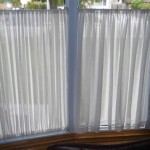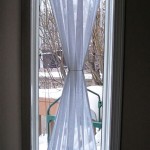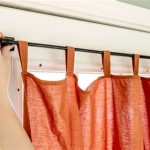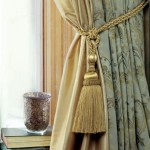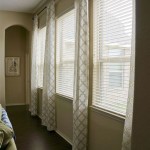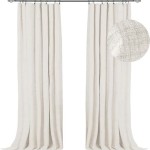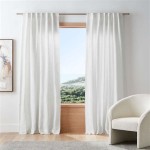Curtains For Closets Without Doors: A Practical and Stylish Solution
Closets are essential storage spaces in any dwelling. They provide refuge for clothing, accessories, and other personal belongings, contributing significantly to an organized and clutter-free living environment. However, not all closets come equipped with doors. This can pose challenges regarding aesthetics, privacy, and dust control. Utilizing curtains as a door alternative presents a viable and often stylish solution, offering practicality and visual appeal to otherwise exposed storage areas.
The decision to employ curtains for closets lacking doors can stem from various factors. Budget constraints often play a role, as curtains are generally more affordable than traditional door installations. Space limitations can also be a key consideration, particularly in smaller rooms where swinging doors might obstruct pathways or furniture placement. Furthermore, homeowners may prefer the aesthetic flexibility that curtains offer, allowing for easy changes in style and color to match evolving decor.
This article will explore the various aspects of using curtains as a closet door alternative, touching upon material selection, installation techniques, design considerations, and the advantages and disadvantages associated with this approach.
Material Selection: Balancing Aesthetics and Functionality
The choice of material for closet curtains is paramount, as it directly impacts both the aesthetic appeal and the practical functionality of the installation. A wide range of fabrics is available, each possessing unique properties that cater to diverse needs and preferences.
Cotton: Cotton is a popular choice due to its versatility, affordability, and ease of care. It is available in various weights and weaves, allowing for customization in terms of light filtration and privacy. Cotton curtains are generally easy to wash and maintain, making them suitable for everyday use. However, cotton is prone to wrinkling and may require ironing to maintain a polished appearance. Furthermore, lighter-weight cotton fabrics may not provide adequate privacy or dust protection.
Linen: Linen offers a sophisticated and airy aesthetic. It is a durable and breathable fabric that drapes beautifully, adding a touch of elegance to any space. Linen curtains provide a moderate level of privacy while allowing some natural light to filter through. However, linen is more expensive than cotton and is prone to wrinkling. It also requires more careful laundering to prevent shrinkage and maintain its shape.
Polyester: Polyester is a synthetic fabric that is known for its durability, wrinkle resistance, and affordability. It is available in a wide range of colors and patterns, offering ample design options. Polyester curtains are easy to clean and maintain, making them a practical choice for high-traffic areas. However, polyester is less breathable than natural fibers and may not drape as elegantly as cotton or linen.
Velvet: Velvet curtains offer a luxurious and opulent aesthetic. They are thick and heavy, providing excellent privacy and sound insulation. Velvet curtains also offer superior light blocking capabilities, making them ideal for bedrooms or media rooms. However, velvet is a high-maintenance fabric that requires professional cleaning. It is also a more expensive option compared to other materials.
Blackout Fabrics: For closets requiring maximum privacy and light blockage, blackout fabrics are an excellent choice. These fabrics are specifically designed to block out all light, making them ideal for bedrooms or closets containing sensitive materials that may be damaged by sunlight. Blackout fabrics are typically made from multiple layers of tightly woven material, offering superior insulation and sound dampening properties. They are available in various colors and textures, allowing for design integration.
Beyond the primary fabric, the choice of lining material also warrants consideration. Lining curtains adds weight, improves insulation, and enhances privacy. It also protects the main fabric from sunlight damage and extends the lifespan of the curtains. Common lining materials include cotton, polyester, and blackout fabrics.
Installation Techniques: Ensuring a Secure and Functional Setup
Proper installation is crucial for ensuring that closet curtains function effectively and enhance the overall aesthetic of the room. The installation process typically involves mounting a curtain rod or track and then hanging the curtains using rings, hooks, or grommets.
Curtain Rods: Curtain rods are the most common method for hanging closet curtains. They are available in various materials, styles, and finishes, allowing for customization to match the room's decor. The rod should be sturdy enough to support the weight of the curtains and long enough to span the width of the closet opening. The rod can be mounted directly to the wall above the closet opening using brackets. Alternatively, tension rods can be used for a no-drill installation, provided the closet opening is narrow enough and the rod is strong enough to hold the weight. It's crucial to ensure the brackets are securely anchored to the wall studs for maximum stability.
Curtain Tracks: Curtain tracks offer a more streamlined and modern aesthetic compared to traditional curtain rods. They are typically made of metal or plastic and allow the curtains to slide smoothly along the track. Curtain tracks can be mounted to the ceiling or the wall, depending on the desired look and functionality. They are particularly well-suited for wider closet openings or for creating a more seamless look. Tracks require accurate measurements and careful installation to ensure smooth operation.
Hanging Methods: Once the rod or track is installed, the curtains can be hung using various methods. Curtain rings are a popular option, providing a classic and elegant look. Rings are attached to the top of the curtains and then slid onto the rod. Hooks are another common option, offering a more concealed hanging method. Hooks are inserted into the back of the curtains and then hung from the rod or track. Grommets are metal rings that are inserted into the top of the curtains, creating a clean and modern look. Curtains with grommets are typically hung directly from the rod.
When installing curtains, it's important to consider the desired length and fullness. The curtains should hang just below the bottom of the closet opening to provide adequate coverage and privacy. The fullness of the curtains will depend on the fabric and the desired look. Generally, curtains should be at least twice the width of the closet opening to create a full and gathered appearance. This ensures adequate coverage and prevents the curtains from appearing stretched or flat.
For closets with uneven surfaces, consider using adjustable curtain rods or tracks to ensure a level and consistent appearance. Shims can also be used behind the mounting brackets to compensate for minor irregularities in the wall.
Design Considerations: Enhancing Aesthetics and Functionality
Beyond the practical aspects of material selection and installation, design considerations play a crucial role in creating closet curtains that are both aesthetically pleasing and functionally effective. The design should complement the overall decor of the room and enhance the usability of the closet space.
Color and Pattern: The color and pattern of the closet curtains should coordinate with the existing color scheme and design elements of the room. Neutral colors, such as white, beige, and gray, are versatile choices that can blend seamlessly with a variety of decor styles. Bold colors and patterns can add a pop of visual interest and personality to the space. When selecting a pattern, consider the size of the room and the scale of the pattern. Smaller rooms may benefit from smaller-scale patterns, while larger rooms can accommodate bolder and more elaborate designs.
Style and Texture: The style and texture of the curtains should also complement the overall aesthetic of the room. Sheer curtains can add a light and airy feel to the space, while heavier fabrics like velvet or brocade can create a more luxurious and formal look. Consider the texture of the fabric and how it will interact with the other textures in the room. For example, a room with smooth, modern surfaces might benefit from curtains with a more textured or tactile fabric.
Hardware: The hardware used to hang the curtains, such as the curtain rod or track, should also be carefully chosen to complement the overall design. Metal rods with decorative finials can add a touch of elegance, while simple wooden rods can create a more rustic or minimalist look. The finish of the hardware should coordinate with the other metal finishes in the room, such as door handles, light fixtures, and cabinet hardware.
Functionality: In addition to aesthetics, functionality should also be a key consideration when designing closet curtains. Consider the specific needs of the closet and choose curtains that are appropriate for the intended use. For example, a closet used for storing clothing might benefit from curtains that are easy to open and close, while a closet used for storing sensitive materials might require curtains that provide maximum privacy and light blockage.
Tiebacks and Accessories: Tiebacks can be used to hold the curtains open, allowing for easy access to the closet contents. They can also add a decorative touch to the curtains. Tiebacks are available in various materials and styles, from simple rope tiebacks to ornate metal holdbacks. Other accessories, such as valances or swags, can also be used to add a decorative touch to the curtains and enhance the overall look of the room.
Consider incorporating elements that enhance the functionality of the closet. For example, adding pockets or organizers to the back of the curtain can provide additional storage space for small items. Magnet strips can be sewn into the bottom of the curtain to help it stay closed and prevent drafts.
By carefully considering these design elements, homeowners can create closet curtains that are both aesthetically pleasing and functionally effective, enhancing the overall look and feel of the room while providing practical storage solutions.

How To Cover A Closet Without Doors Thistlewood Farm

How To Cover A Closet Without Doors 5 Most Effective Ways Tribesigns

How To Cover A Closet Without Doors Thistlewood Farm

Xtmyi Off White Ivory Velvet Sliding Closet Door Curtain Without

How To Cover A Closet Without Doors 5 Most Effective Ways Tribesigns

How To Cover A Closet Without Doors Thistlewood Farm

Closet Curtains Instead Of Doors Saw This In A The Other Night Too And Freaked About How Much I Love Idea

Top 15 Closet Door Alternatives To Enhance Your Space

Curtain For Closet Without Door Accordion Folding Doorway

How To Cover A Closet Without Doors 5 Most Effective Ways Tribesigns

